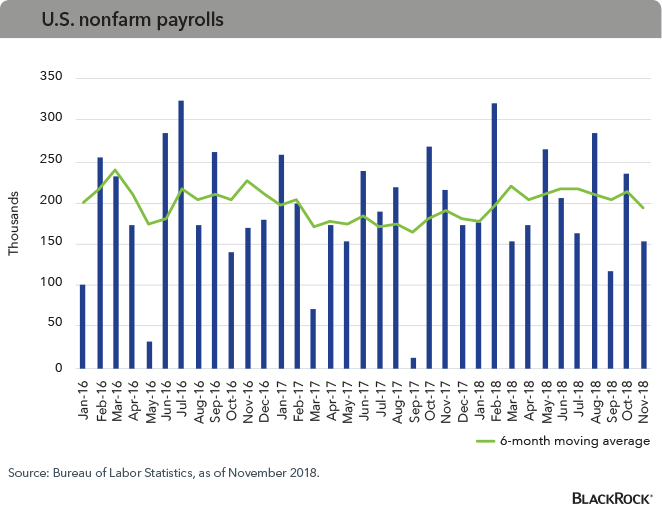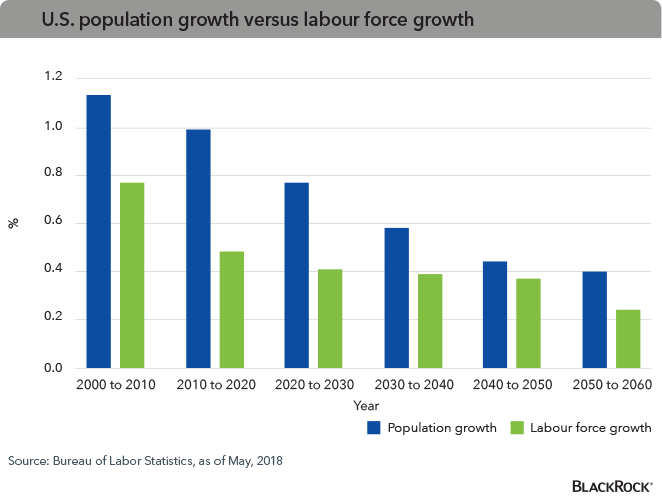by Rachel Siu, Blackrock
As the Federal Reserve (Fed) and Bank of Canada (BoC) policy rates approach neutral (the level at which monetary policy neither stimulates nor restricts growth), both central banks have emphasized future rate decisions will be guided by incoming data. Accordingly, investors trying to discern the path of monetary policy have become hyper-focused on economic data releases. One particular report that seems to attract outsized investor (and media) attention is the monthly release of the U.S. employment situation, which captures the change in total non-farm payrolls (NFP) and average hourly earnings.
Most recently, the November NFP lagged consensus at 155,000 and there were downward revisions to the prior two months’ numbers. The increase in average hourly earnings also came in slightly below expectations though it was still a healthy 3.1% annualized pace.
While the latest numbers disappointed expectations, we believe the moderation in job creation is part of a larger, more structural factor at play: demographics.
Taking a step back, the average number of new jobs added each month has hovered around an impressive 200,000, as the U.S. economy recovered from the depths of the credit crisis. These robust levels of job growth have driven the unemployment rate to an 18-year low of 3.7%.
As the U.S. economy hits late-cycle, NFP numbers will (and should) trend lower, guided by demographic trends. Projections by the Bureau of Labor Statistics (BLS) indicate U.S. population growth – and more importantly, labour force growth – will slow in the coming years, due to factors like declining fertility rates and aging baby boomers.
As for what the long-term figure is for monthly payrolls, it depends on a range of variables, though past statements from the Fed have indicated a sustainable level may be closer to 100,000 per month. Whatever that number may be, it’s clear investors will have to adjust expectations and recognize the larger economic forces at play.
In terms of policy implications, we believe these conditions point to a much more gradual pace of rate hikes by both the BoC and the Fed in 2019 than we saw in 2018. Despite historically low unemployment, inflation is well-contained and we see central banks pausing the hiking cycle to assess the effects of slowing economic momentum and tightening financial conditions.
Rachel Siu, Director, Product Strategy team, is a regular contributor to the Canadian blog
This material is not intended to be relied upon as a forecast, research or investment advice, and is not a recommendation, offer or solicitation to buy or sell any securities or to adopt any investment strategy. The opinions expressed are as of the date indicated and may change as subsequent conditions vary. The information and opinions contained in this post are derived from proprietary and nonproprietary sources deemed by BlackRock to be reliable, are not necessarily all-inclusive and are not guaranteed as to accuracy. As such, no warranty of accuracy or reliability is given and no responsibility arising in any other way for errors and omissions (including responsibility to any person by reason of negligence) is accepted by BlackRock, its officers, employees or agents. This post may contain “forward-looking” information that is not purely historical in nature. Such information may include, among other things, projections and forecasts. There is no guarantee that any of these views will come to pass. Reliance upon information in this post is at the sole discretion of the reader.
© 2018 BlackRock Asset Management Canada Limited. All rights reserved. iSHARES and BLACKROCK are registered trademarks of BlackRock, Inc., or its subsidiaries in the United States and elsewhere. Used with permission.
ICR1218C-687223-2117084
Copyright © Blackrock Blog














